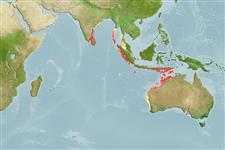分類 / Names
俗名 | 同種異名 | Catalog of Fishes(屬, 種) | ITIS | CoL | WoRMS | Cloffa
Teleostei >
Eupercaria/misc (Various families in series Eupercaria)
鱸形目 (Various families in series Eupercaria) >
Labridae (Wrasses)
隆頭魚科 (Wrasses)
Etymology: Paracheilinus: Greek, para = the side of + Greek, chaite = hair + Greek, odous = teeth (Ref. 45335).
Environment: milieu / climate zone / depth range / distribution range
生態學
海洋 礁區魚類; 深度上下限 6 - 35 m (Ref. 90102). 熱帶
Eastern Indian Ocean: Indonesia and northwestern Australia.
東印度洋: 印尼與澳洲西北部。
大小 / 重量 / 年齡
Maturity: Lm ? range ? - ? cm
Max length : 8.5 cm TL 雄魚/尚未辨別雌雄; (Ref. 48636)
Males display with bright yellow anal fins and red spikes on the dorsal fin that vary from a single to 4. More often they have 2 or 3 (Ref. 48636).
雄性在改變的背鰭上顯現鮮黃色的臀鰭與紅色的長釘從一到 4. 更時常,他們有 2 或 3 。 (參考文獻 48636)
Inhabits rubble and weedy bottoms of seaward reefs (Ref. 90102). Also found in coastal reef slopes and estuaries. Occurs in small groups with numerous females, juveniles and several males, often covering a large section of reef. Juveniles are secretive when small and form small groups at later stages (Ref. 48636).
發現於海岸的礁斜坡與河口了。 形成小群魚群有很多的雌性,稚魚與一些雄性, 時常包含的一個礁的大部分。 稚魚是躲躲藏藏的當小的而且在較後的階段形成小群魚群.(參考文獻 48636)
Life cycle and mating behavior
成熟度 | 繁殖 | 產卵場 | 卵 | 孕卵數 | 仔魚
Oviparous, distinct pairing during breeding (Ref. 205).東印度洋: 印尼與澳洲西北部。
Parenti, P. and J.E. Randall, 2000. An annotated checklist of the species of the labroid fish families Labridae and Scaridae. Ichthyol. Bull. J.L.B. Smith Inst. Ichthyol. (68):1-97. (Ref. 35918)
人類使用
更多資訊
參考文獻養殖養殖資訊品種遺傳學Electrophoreses遺傳率疾病加工NutrientsMass conversion
合作者照片Stamps, Coins Misc.聲音神經毒速度泳型鰓區Otoliths腦重體重比眼睛色素
工具
特別的報告
下載 XML
網路資源
Estimates based on models
Preferred temperature (Ref.
123201): 26.4 - 28.6, mean 27.8 °C (based on 38 cells).
Phylogenetic diversity index (Ref.
82804): PD
50 = 0.5000 [Uniqueness, from 0.5 = low to 2.0 = high].
Bayesian length-weight: a=0.00955 (0.00456 - 0.02002), b=3.06 (2.89 - 3.23), in cm total length, based on LWR estimates for this (Sub)family-body shape (Ref.
93245).
營養階層 (Ref.
69278): 3.4 ±0.4 se; based on size and trophs of closest relatives
回復力 (Ref.
120179): 高度, 族群倍增時間少於 15個月 (Preliminary K or Fecundity.).
Fishing Vulnerability (Ref.
59153): Low vulnerability (10 of 100).
Nutrients (Ref.
124155): Calcium = 132 [76, 269] mg/100g; Iron = 1.03 [0.58, 1.99] mg/100g; Protein = 18.2 [15.2, 20.4] %; Omega3 = 0.172 [0.096, 0.300] g/100g; Selenium = 22.9 [12.2, 45.9] μg/100g; VitaminA = 253 [76, 921] μg/100g; Zinc = 1.98 [1.27, 3.13] mg/100g (wet weight);
